Related Research Articles
Discharge may refer to
Urethritis is the inflammation of the urethra. The most common symptoms include painful or difficult urination and urethral discharge. It is a commonly treatable condition usually caused by infection with bacteria. This bacterial infection is often sexually transmitted, but not in every instance; it can be idiopathic, for example. Some incidence of urethritis can appear asymptomatic as well.

Conjunctivitis, also known as pink eye, is inflammation of the outermost layer of the white part of the eye and the inner surface of the eyelid. It makes the eye appear pink or reddish. Pain, burning, scratchiness, or itchiness may occur. The affected eye may have increased tears or be "stuck shut" in the morning. Swelling of the white part of the eye may also occur. Itching is more common in cases due to allergies. Conjunctivitis can affect one or both eyes.

Sputum is mucus that is coughed up from the lower airways. In medicine, sputum samples are usually used for a naked eye examination, microbiological investigation of respiratory infections and cytological investigations of respiratory systems. It is crucial that the specimen does not include any mucoid material from the nose or oral cavity.

Rheum is a thin mucus naturally discharged from the eyes, nose, or mouth, often during sleep. Rheum dries and gathers as a crust in the corners of the eyes or the mouth, on the eyelids, or under the nose. It is formed by a combination of mucus, nasal mucus, blood cells, skin cells, or dust.
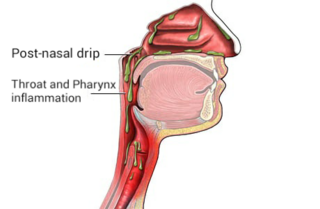
Post-nasal drip (PND), also known as upper airway cough syndrome (UACS), occurs when excessive mucus is produced by the nasal mucosa. The excess mucus accumulates in the back of the nose, and eventually in the throat once it drips down the back of the throat. It can be caused by rhinitis, sinusitis, gastroesophageal reflux disease (GERD), or by a disorder of swallowing. Other causes can be allergy, cold, flu, and side effects from medications.
Proctitis is an inflammation of the anus and the lining of the rectum, affecting only the last 6 inches of the rectum.

Lung abscess is a type of liquefactive necrosis of the lung tissue and formation of cavities containing necrotic debris or fluid caused by microbial infection.
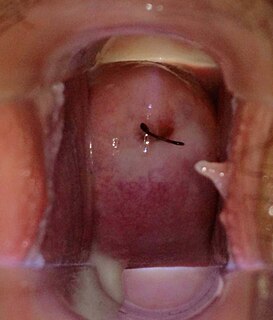
Vaginal discharge is a mixture of liquid, cells, and bacteria that lubricate and protect the vagina. This mixture is constantly produced by the cells of the vagina and cervix, and it exits the body through the vaginal opening. The composition, amount, and quality of discharge varies between individuals and can vary throughout the menstrual cycle and throughout the stages of sexual and reproductive development. Normal vaginal discharge may have a thin, watery consistency or a thick, sticky consistency, and it may be clear or white in color. Normal vaginal discharge may be large in volume but typically does not have a strong odor, nor is it typically associated with itching or pain. While most discharge is considered physiologic or represents normal functioning of the body, some changes in discharge can reflect infection or other pathological processes. Infections that may cause changes in vaginal discharge include vaginal yeast infections, bacterial vaginosis, and sexually transmitted infections. The characteristics of abnormal vaginal discharge vary depending on the cause, but common features include a change in color, a foul odor, and associated symptoms such as itching, burning, pelvic pain, or pain during sexual intercourse.

Phlyctenular keratoconjunctivitis is an inflammatory syndrome caused by a delayed hypersensitivity reaction to one or more antigens. The triggering antigen is usually a bacterial protein, but may also be a virus, fungus, or nematode.
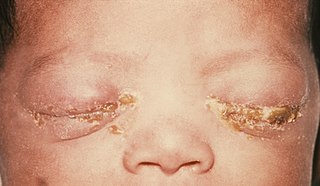
Neonatal conjunctivitis is a form of conjunctivitis which affects newborn babies following birth. It is typically due to neonatal bacterial infection, although can also be non-infectious. Infectious neonatal conjunctivitis is typically contracted during vaginal delivery from exposure to bacteria from the birth canal, most commonly Neisseria gonorrhoeae or Chlamydia trachomatis.
Bovine alphaherpesvirus 1 (BoHV-1) is a virus of the family Herpesviridae and the subfamily Alphaherpesvirinae, known to cause several diseases worldwide in cattle, including rhinotracheitis, vaginitis, balanoposthitis, abortion, conjunctivitis, and enteritis. BoHV-1 is also a contributing factor in shipping fever, also known as bovine respiratory disease (BRD). It is spread horizontally through sexual contact, artificial insemination, and aerosol transmission and it may also be transmitted vertically across the placenta. BoHV-1 can cause both clinical and subclinical infections, depending on the virulence of the strain. Although these symptoms are mainly non-life-threatening it is an economically important disease as infection may cause a drop in production and affect trade restrictions. Like other herpesviruses, BoHV-1 causes a lifelong latent infection and sporadic shedding of the virus. The sciatic nerve and trigeminal nerve are the sites of latency. A reactivated latent carrier is normally the source of infection in a herd. The clinical signs displayed are dependent on the virulence of the strain. There is a vaccine available which reduces the severity and incidence of disease. Some countries in Europe have successfully eradicated the disease by applying a strict culling policy.
Ovine rinderpest, also commonly known as peste des petits ruminants (PPR), is a contagious disease primarily affecting goats and sheep; however, camels and wild small ruminants can also be affected. PPR is currently present in North, Central, West and East Africa, the Middle East, and South Asia. It is caused by small ruminants morbillivirus in the genus Morbillivirus, and is closely related to, among others, rinderpest morbillivirus, measles morbillivirus, and canine morbillivirus. The disease is highly contagious, and can have an 80–100% mortality rate in acute cases in an epizootic setting. The virus does not infect humans.

Tyloxapol is a nonionic liquid polymer of the alkyl aryl polyether alcohol type. It is used as a surfactant to aid liquefaction and removal of mucopurulent bronchopulmonary secretions, administered by inhalation through a nebulizer or with a stream of oxygen.
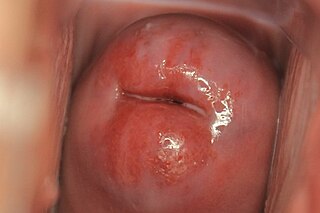
Cervical ectropion is a condition in which the cells from the 'inside' of the cervical canal, known as glandular cells, are present on the 'outside' of the vaginal portion of the cervix. The cells on the 'outside' of the cervix are typically squamous epithelial cells. Where the two cells meet is called the transformation zone, also known as the stratified squamous epithelium. Cervical ectropion can be grossly indistinguishable from early cervical cancer and must be evaluated by a physician to determine risks and prognosis. It may be found incidentally when a vaginal examination is done. The area may look red because the glandular cells are red. While many women are born with cervical ectropion, it can be caused by a number of reasons, such as:
A cervical mucus plug (operculum) is a plug that fills and seals the cervical canal during pregnancy. It is formed by a small amount of cervical mucus.

Acute Haemmorrhagic Conjunctivitis is the inflammation of the conjunctiva of sudden onset. It presents as a reddening of the eye due to the infection of the conjunctiva. The conjunctiva is the thin transparent tissue that covers the eye from the Corneal limbus to the lid margin. Many conditions can lead to the inflammation of the conjunctiva. They include allergies, bacterial infection, viral infection etc. A common form of the condition that occurs every rainy season is the seasonal conjunctivitis popularly referred to as "Apollo" by West Africans because the reports of its first epidermic in Accra coincided with the Apollo 11 moon landing. Every year prior to the rainy season in the country, various health warnings are given to remind citizens of the condition.
Rectal discharge is intermittent or continuous expression of liquid from the anus. Normal rectal mucus is needed for proper excretion of waste. Otherwise, this is closely related to types of fecal incontinence but the term rectal discharge does not necessarily imply degrees of incontinence. Types of fecal incontinence that produce a liquid leakage could be thought of as a type of rectal discharge.
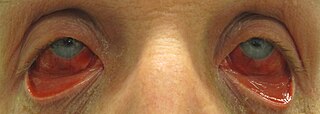
Acute hemorrhagic conjunctivitis (AHC) is a derivative of the highly contagious conjunctivitis virus, otherwise known as pink eye. Symptoms include excessively red, swollen eyes as well as subconjunctival hemorrhaging. Currently, there is no known treatment and patients are required to merely endure the symptoms while the virus runs its five- to seven-day course. While it was first identified in Ghana, the virus has now been seen in China, India, Egypt, Cuba, Singapore, Taiwan, Japan, Pakistan, Thailand, and the United States.
Blennorrhoea aka blennorrhagia or myxorrhoea, is a medical term denoting an excessive discharge of watery mucus, especially from the urethra or the vagina, and also used in ophthalmology for an abnormal discharge from the eye, but now regarded as a synonym for conjunctivitis and accordingly rarely used.